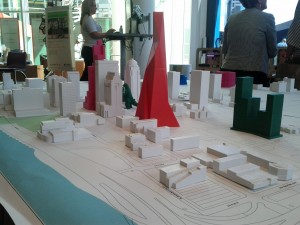
The entries for the first annual Life of an Architect Playhouse Design Competition are due in 29 Days (April 16th, 2012)!!!
Who can enter?
This competition will be open to anyone from anywhere – the only entry criteria is the following:
§ there is no entry criteria!
That’s pretty much it, so there really isn’t a good reason not to submit. Oh, did I mention that there’s no fee required to enter!! It just keeps getting better and better doesn’t it?
What do I submit?
All submissions are required to be in electronic form with a file size not to exceed 5MB. For the judging process, you should submit plans, elevations, sections, perspectives … whatever you feel best conveys your design. Whatever drawings you do choose to create need to be arranged on a 24″ x 36″ board oriented vertically – this is very important that you follow these submission guidelines. I would humbly request that no animations be submitted. Right below you will see an example of the sort of entry graphic I am talking about …

You might remember this playhouse from none other than frequent Life of an Architect collaborator and talented designer Scott Taylor (see the feature post on this design – including construction drawings – here). This is the format you should use as an example, even paying attention to the types of drawings Scott included – he did a great job conveying his design intent along with just enough information on how this playhouse might be built.
**You are not required to generate construction drawings unless your design is selected as a winner**
.How do I register?
Please send an email to me – bob@lifeofanarchitect.com and put “Playhouse Competition” in the subject line. In the email, tell me who you are, what you do (architect, intern, student, housewife, phlebotomist – etc.) and current location of residence (just city, state, country – I don’t need your home address). If you want to include some additional biographical information about yourself feel free. I will respond to your email and send you the design guidelines (these playhouses have to get moved around so there are size limitations).
.Judging
The judging process will be handled in two rounds; the first round will be a review of all the entries judged by me and up to 4 other people who will be chosen at a later date. The number of qualified entries we receive will determine how many entries will advance to the final judging round but I am shooting for around 20%. The criteria used for judging will be:
§ creativity
§ appeal
§ originality
§ buildability, and
§ the ability of the playhouse to be built for approximately $4,000 in material costs
On the costs, there are lots of people who don’t know how much stuff costs and that’s okay. The point is that you need to be considerate of the cost as you are designing your playhouse – which means designs that require CNC routers, GFRG castings, or cast in place stainless steel will most likely not advance to the final round. Entries can be submitted by individuals or by a team, it doesn’t matter and will not be a consideration during the judging. I will also feature all the entries that advance onto the final judging round here on the site.
.Timeline
Registration is currently happening!! – so send me that email (bob@lifeofanarchitect.com with “Playhouse Competition” in the subject line – remember?)
April 16th – design submissions will be due. Deliverable will be a 24″x36″ vertically oriented JPEG or PNG file format emailed to bob@lifeofanarchitect.com (file size not to exceed 5MB). In the case of multiple entries by a single designer (person or group), please send each entry by itself. Do not place any personal information (like your name) on your digital submission – I want to keep things fair during the judging process.
April 23rd – initial round of judging (by celebrity judges not yet selected) to bring number of entries to be judged to manageable number of finalists will be complete with the finalists announced here on the Life of an Architect website.
April 30th – the final judging round will be completed and the winners will be announced here on the Life of an Architect website.
May 28th – Winners are required to prepare construction drawings (with possible value engineering considerations) for their entries and submit final construction drawings to the designated contractors.
Playhouses will be constructed and ready for delivery to Dallas CASA by the beginning of August to be raffled off.
.Reference information?
If you want, here is a link to every post I’ve written on the Parade of Playhouses (here) which includes construction drawings and a ridiculous number of construction photos and insider tips.
.Information on Dallas CASA
Dallas CASA (which stands for Court Appointed Special Advocates) is a nonprofit organization of community volunteers trained and supervised to serve as voices in court for abused and neglected children. On any day in Dallas County, there are nearly 2,000 children waiting for a safe place to live. Many times the CASA volunteer is the only constant in the child’s life during this very difficult process. Parade of Playhouses raises funds for Dallas CASA to continue serving more children who need safe, permanent homes where they can thrive.
.Special Thanks to:

This is the second year in a row that AUI Contractors has stepped up and funded the construction of several of these playhouses. I became familiar with AUI thanks to Tim Guedry, a friend of mine dating back to high school who is now the Director of Commercial Construction Services for AUI. Considering that I am primarily a residential architect, their financial commitment speaks to how much they care about the work Dallas CASA is doing in the community.













































